#Buddha Vairocana
Photo

Gilt Bronze Seated Buddha Vairocana (China, Tony dynasty, c 720 CE)(唐 鎏金青銅毗盧遮那佛坐像). The teaching gesture made by this figure, with the thumb of the right hand touching the little finger of the left, identifies him as Vairocana, the celestial Buddha who resides at the center of the cosmos. Vairocana is considered a transcendent form of the historical Buddha Shakyamuni. Though similar in appearance, he exists on another plane, unhindered by a mortal body.
[Scott Horton]
* * * *
“Often, it is this anguish of parting - the death of a loved one, the breaking apart of a deep relationship, even the growing up of our children - that propels us into the search for a reality that will never let us down; so this opening passage illustrates, through the experience of Maitreyi, the state of seriousness, of being shocked into alertness, that makes one ready to absorb spiritual insight.”
― Eknath Easwaran, The Upanishads
27 notes
·
View notes
Text

New Buddha statues
2 notes
·
View notes
Text
More on the Origins of Sun Wukong's Golden Headband
I've previously suggested that the Monkey King's golden headband (jingu, 金箍; a.k.a. jingu, 緊箍, lit: “tight fillet”) can be traced to a ritual circlet mentioned in the Hevajra Tantra (Ch: Dabei kongzhi jingang dajiao wang yigui jing, 大悲空智金剛大教王儀軌經, 8th-century). This is one of the "Five Symbolic Ornaments" or "Five Seals" (Sk: Pancamudra, पञ्चमुद्रा; Ch: Wuyin, 五印; a.k.a. "Five Buddha Seals," Wufo yin, 五佛印), each of which is associated with a particular Wisdom Buddha:
Aksobhya is symbolised by the circlet, Amitabha by the ear-rings, Ratnesa by the necklace, Vairocana by the hand ornaments, [and] Amogha by the girdle (Farrow, 1992, p. 65). [1]
輪者,表阿閦如來;鐶者,無量壽如來;頸上鬘者,寶生如來;手寶釧者,大毘盧遮那如來;腰寶帶者,不空成就如來。
Akshobya is known to have attained Buddhahood through moralistic practices (Buswell & Lopez, 2014, p. 27). Therefore, this explains why a headband would be used to rein in the unruly nature of a murderous monkey god.
The original Sanskrit Hevajra Tantra calls the circlet a cakri (चक्रि) or a cakrika (चक्रिका) (Farrow, 1992, pp. 61-62 and 263-264, for example), both of which refer to a "wheel" or "disc." The Chinese version uses the terms baolun/zhe (寶輪/者, "treasure wheel or ring") and just lunzhe (輪者, "wheel" or "ring").
One of the more interesting things I've learned is that these ornaments were made from human bone. One source even refers to them as "bone ornaments" (Sk: asthimudra, अस्थिमुद्रा) (Jamgon Kontrul Lodro Taye, 2005, p. 493, n. 13). [1]
Can you imagine Sun Wukong wearing a headband made from human bone?! How metal would that be? Finger bones would probably do the trick.
Note:
1) Another section of the Hevajra Tantra provides additional associations:
The Circlet worn on the head symbolises the salutation to one's guru, master and chosen deity; the ear-rings symbolise the yogi turning a deaf ear to derogatory words spoken about the guru and Vajradhara; the necklace symbolises the recitation of mantra; the bracelets symbolises the renunciation of killing living beings and the girdle symbolises the enjoyment of the consort (Farrow, 1992, p. 263-264).
謂頂相寶輪者,唯常敬禮教授阿闍梨及自師尊;耳寶鐶者,不樂聞說持金剛者及自師尊一切過失、麁惡語故;頸寶鬘者,唯常誦持大明呪故;手寶釧者,乃至不殺蠕動諸眾生故;腰寶帶者,遠離一切欲邪行故。
2) For more info on the association between Hindo-Buddhist practices and human remains, see "charnel grounds".
Sources:
Farrow, G. W. (1992). The Concealed Essence of the Hevajra Tantra: With the Commentary Yogaratnamālā. Delhi: Motilal Banarsidass.
Jamgon Kontrul Lodro Taye (2005). The Treasury of Knowledge, Book Six, Part Four: Systems of Buddhist Tantra (The Kalu Rinpoche Translation Group, Trans.). Ithaca, NY: Snow Lion.
#Golden headband#tight fillet#Sun Wukong#Monkey King#Esoteric Buddhism#Vajrayana Buddhism#ritual#Journey to the West#JTTW#Lego Monkie Kid
48 notes
·
View notes
Text

Vairocana Buddha, Japan Edo Period 17th Century
UMMA
38 notes
·
View notes
Text
From “The Flower Bank World” in the Avatamsaka Sutra

The Buddhist Painting of Songgwansa Temple, Suncheon, South Korea (Illustration of Avatamsaka Sutra)
“Then Universally Good also said to the assembly, ‘In the land masses of this ocean of worlds are seas of fragrant waters, as numerous as atoms in unspeakably many buddha-fields. All beautiful jewels adorn the floors of those seas; gems of exquisite fragrances adorn their shores. They are meshed with luminous diamonds. Their fragrant waters shine with the colors of all jewels. Flowers of all kinds of gems swirl on their surfaces. Sandalwood powder settles on the bottom of the seas. They emanate the sounds of Buddhas’ speech. They radiate jewellike light. Boundless enlightening beings, holding various canopies, manifest mystic powers causing the adornments of all worlds to appear therein. Stairways of ten kinds of precious substances are set out in rows, with balustrades of ten kinds of jewels surrounding them. White lotuses ornamented with jewels, as many as atoms in four continents, are spread over the waters, in full bloom. There are unspeakable hundreds of thousands of billions of trillions of banners of ten precious elements, banners of belled gauze of raiments of all jewels, as many as sand grains in the Ganges river, jewel flower palaces of boundless forms, as many as sand grains in the Ganges river, a hundred thousand billion trillion lotus castles of ten precious substances, forests of jewel trees as many as atoms in four continents, networks of flaming jewels, as many sandalwood perfumes as grains of sand in the Ganges, and jewels of blazing radiance emitting the sounds of Buddhas’ speech…”
--From book five “The Flower Bank World” in the The Flower Ornament Scripture (Buddhāvataṃsaka Sūtra), translated from Chinese by Thomas Cleary. The various sutras were originally composed in Sanskrit and compiled and translated into Chinese in the 5th century CE. Thomas Cleary’s English translation is based on the Chinese translation done by the Khotanese monk Shikshananda (652-710 CE), who translated it at the request of the Tang Empress.
I stumbled upon this sutra in the back of a book that included a ‘glossary of buddhist terms’ while at a Zen meditation retreat. Flower cosmology? That sounds like my shit. Since I didn’t have my phone I wrote the name down on a piece of paper and slipped it into my backpack. It really is as incredible as I imagined it to be.
“Alan Fox has described the sutra's worldview as ‘fractal’, ‘holographic’, and ‘psychedelic’”—yes.
“In the Huayan school, the teaching of interpenetration is depicted through various metaphors, such as Indra's net, a teaching which may have been influenced by the Gandhavyuha chapter's climax scene in Vairocana's Tower. Indra's net is an infinite cosmic net that contains a multifaceted jewel at each vertex, with each jewel being reflected in all of the other jewels, ad infinitum. Thus, each jewel contains the entire net of jewels reflected within.”
#Avataṃsaka Sūtra#Avatamsaka Sutra#flower garland sutra#Hwaeom#Kegon#Huayan Buddhism#Huayan#chan buddhism#Xianshou#water#buddhism#religion#mysticism#Thomas Cleary#literature#philosophy#metaphysics of flowers#The Flower Ornament Scripture#Buddhāvataṃsaka Sūtra#Buddhāvataṃsaka-nāma-mahāvaipulya-sūtra#Sanskrit
65 notes
·
View notes
Text
GOJO'S DEEP CONNECTION TO BUDDHISM

SIX ELEMENTS
to first understand gojo's deep connection to buddhism, it's important to talk about esoteric buddhism and the six elements. very similar to china's five elements esoteric buddhism has the five elements as: earth, water, fire, air/wind, space/void. however, esoteric buddhism as one additional element the mind. gojo's powers involve space ( his manipulation of space itself and his domain expansion being called unlimited void ). gojo's journey to becoming the strongest was not complete until he opened his mind. as stated, by adding the sixth element the mind, it creates a unity between all five elements. if one lacks the sixth element, ordinary eyes see only the differientated forms/appearances.
this ties in with the fact that gojo's eyes allow him to see things most people cannot see ( people's souls in colors, reading the flow of cursed energy, viewing of his opponent's cursed technique, object dection with or without cursed energy, & being able to see kilometers away ). it can also be said that being born as the six eyes user brought balance, a connection to how the mind element creates unity.
SATORI
in zen buddhism, this is the term for awakening in japanese zen buddhism. it means comprehension, understanding. the word is derived from the japanese verb satoru, who's first name is satoru? gojo's. to put it further, satori refers to an awakening or apprehension of the true nature of reality. it's used to describe an experience that can't be expressed via words. gojo goes through his enlightenment, his death, and never does he really talk about what he went through. he talks about an indescribable feeling, feelng the whole world, this connection to it and to feel everything happening, but if anyone were to ask him how he felt touching the core of cursed energy he would not be able to explain it properly. it is an experience he will never fully properly explain.
another way this ties into gojo is that his confrontation with toji, is something of an antagonistic one. in the way, that after the second fight he truly dislikes having a lack of control, he doesn't want to feel hepless, or be helpless with all the immense power that he has. gojo is forced to face the reality of defeat, the reality of having little control at all, and the fact that he didn't fully realize the capabilities of his powers. in the modern era of jujutsu, gojo is the standard.
ALLUSIONS TO OTHER FIGURES IN BUDDHISM
VAIROCANA
part of the five great buddhas or the five tathāgatas, they are seen as the five representations of the adi-buddha ( aka the first buddha). vairocana is associated with the color white ( gojo's hair is white ), vairocana represents the element of space, which coincides with gojo's technique and ability manipulate space itself. the cardinal direction vairocana represents is the center and the season they represent is a transition. gojo could be considered a big transition in the way the jujutsu world operated as, again his birth balanced out the jujutsu world. it is also a big transition in being dubbed the strongest sorcerer of his era.
MARICI
a goddess associated with the light and sun. alternatively, in japan she is also associated with light or mirage and was invoked to escape enemies. she has several depictions and in some she carries the lotus with her. in gojo's dream/death sequence, there is a drawing of a lotus flower. the lotus flower in buddhism represents purity, spiritual awakening, and faiththfulness. it also symbolizes rebirth ( which will be furthered tied down to another section ) and the implications of nanami and gojo's conversation hints at a rebirth of some sort.
THE SIGNIFICANCE OF THE FOUR DIRECTIONS
in buddhism, there is great importance in north, east, south, and west. for this particular post i will be focusing on the two directions of north and south.
"I ONCE ASKED MEI-SAN ABOUT WHERE I SHOULD LIVE. SHE SAID IF YOU'D LIKE TO BECOME SOMEONE NEW. GO NORTH."
the north is considered a symbol of stability, a fixed goal that never wavers. it also represents unshakeable conviction. when your will is strong, you are under the protection of the guide of the north. when you become unstable, the grace of god pulls you in the right direction. it should be noted that gojo does say i see, gives a wave. in my opinion, it implicates that gojo has determined to go north. gojo is also the type of person who has a strong conviction, his will to ensure that the future of jujutsu sorcery can be on his level, to be strong enough to compete with himself, so that they never have to endure what he/geto went through. gojo is someone who will always aim higher to break the ceiling even if he is the ceiling.
alternatively, there is another direction that is mentioned in said chapter:
"IF YOU'D LIKE TO RETURN TO WHO YOU WERE, GO SOUTH."
the south is associated with death. it offers complete rest. when the body can no longer lead us down our path, the protector of the south, yama raja, lord of death, ensures we get rid of our vehicle ( the body ) and gives us a new one. the catch is that in general, we form attachments to our body, mind, and senses and we have a hard time of letting go. however, once someone does they will find that 'long sleep' is a restful. this line goes in hand with nanami who doesn't hesitate to go south, stuck in the past since he still had attachments to haibara, and in a sense yuji. but at the end of it he was able to let go.
#✧ → ᴡʜᴀᴛ ᴅᴏ ᴛʜᴏsᴇ ᴇʏᴇs sᴇᴇ ᴛʜʀᴏᴜɢʜ? ( ʜᴄ. )#✧ → ᴅɪᴅ ʏᴏᴜ ʀᴇᴀᴄʜ ᴇɴʟɪɢʜᴛᴇɴᴍᴇɴᴛ ? ( sᴛᴜᴅʏ. )#q.#yes the second half is me coping#but i truly believe there's a lot of set up for this#also gojo being paired up with the lotus flower#all very very telling#it's been a lot of research#cross referencing a lot of stuff#you can also make the case that gojo is bodhisattva#hmm maybe i'll cook that
13 notes
·
View notes
Photo



“Now, I, Vairocana Buddha, am sitting atop a lotus pedestal; on a thousand flowers surrounding me are a thousand Sakyamuni Buddhas. Each flower supports a hundred million worlds; in each world a Sakyamuni Buddha appears. All are seated beneath a Bodhi-tree, all simultaneously attain Buddhahood. All these innumerable Buddhas have Vairocana as their original body. “
--The Brahma’s Net Sutra
Om a-vi-ra-hûm-kham vajradhâtu vam (Skt.)
Om All Pervading One; Imperishable One
"Dhyani Buddha"
Vairochana, the Illuminator
Talon Abraxas M/J
93 notes
·
View notes
Text
The Solar System
I'm thinking of how we technically have all the solar system represented in the world of One Piece. There's the sun, Nika. The planets Mercury to Saturn in the form of the Gorousei. The remaining outermost planets Uranus, Neptune, and Pluto are represented by the three ancient weapons. Then the Earth is just the world itself.
Certainly sensei did swap out Neptune for Poseidon, but it could be a distraction to obfuscate the themes. Because then the three ancient weapons just looks like they're named after Greek/Roman gods, and people might not necessarily think of the planets.
A while ago, I started formulating theories about the moon because I saw the kuyou/Navagraha symbol on the Koudzuki crest. It is a big circle with 8 smaller circles around it. I have since saw other people pointing out that similar-looking symbols were sighted in other One Piece locations. The Arabasta symbol and Skypiea, for example.

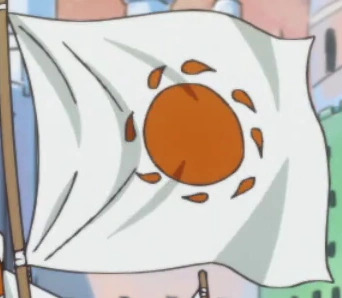

Also arguably, King Neptune's tattoo:

The symbol stands for the sun (the big middle circle), the moon, and the 5 planets. The Skypiea symbol even has the word "god" in the big middle circle, which is interesting. Anyway. The moon aside, which we have very little info about as of now, the 5 planets' current representation is the Gorousei, who are "evil". This seems rather odd.
So, I wonder if Imu is the "dark/evil sun" and the Gorousei is also just the "evil version" of the planets. Some time ago, I mentioned that a Japanese fan thought that if you combine the katakana for Imu's name, Nerona Imu, you will get the kanji "kami" (god) and "hotoke" (Buddha):

How does this imply the sun? The most important kami in Japan is Amaterasu, the sun goddess. One of the most important Buddhas in Japan is the Dainichi Nyorai 大日如来 (Vairocana). Dainichi literally means "great sun".
In which case, if the WG's Gorousei is "evil", maybe in the past there is a "good version" of the 5 planets' representations, and that maybe later a new "good Gorousei" will be formed in the fight against the World Government.
That is, maybe the final fight is "the solar system" (Luffy, 5 "planets", the 3 ancient weapons, and something representing the moon) will fight Imu and the WG.
Related to my Yonkou elemental analysis. Maybe the "good planets" will be the Yonkou + 1 more person (representing the "land", as opposed to the pirates that represent the "sea"). The Gorousei is "stars", celestial bodies. So people representing the seas and land, the "opposite" of the skies, fighting them is thematically fitting.
Luffy is the sun, so a new Yonkou might take his place. And it's hard to see Blackbeard helping, even though he has the "D" name, so maybe the Yonkou members will shift around some more later.
Or it might not be the Yonkou. It's way too early to tell, but this is just a preliminary thought.
17 notes
·
View notes
Note
What are the exact name ofthose Buddha statues Iori made you posted? Besides the Boss one
The Earth statue is Bishamonten, one of the Seven Lucky Gods of Japan. Aside from Ebisu, who is a purified Hiruko, all of the Seven Lucky Gods are regional variants of gods imported from China and India. Bishamonten specifically is Kuvera, a Hindu wealth god who was promoted to a Buddhist guardian deva (Buddhist name: Vaisravana). Notorious avatars of Kuvera include Li Jing (Nezha's father, avatar status canon to Type-Moon Pan-Human History), Sakanoue no Tamuramaro (Suzuka Gozen's husband, avatar status unclear in Type-Moon), and Uesugi Kenshin (Nagao Kagetora, avatar status maybe exclusive to Gudaguda).
The Water statue is Maha Vairocana, the most central and most perfected entity in Mahayana Buddhism. The Buddha above all Buddhas and Bodhisattvas, so to speak. In 752, Emperor Shoumu established that Maha Vairocana is the Buddha form of sun goddess Amaterasu, a belief established as canon to Type-Moon. Amaterasu/Vairocana shows her actual face in Tamamo's route of CCC, so she's the only one in the post where I put a picture of the actual Buddha instead of an avatar.
The Wind statue is a Bodhisattva known by the Japanese name Kanzeon (frequently shortened to Kannon) or the Sanscrit name Avalokitesvara, but certainly more popular by the Chinese name Guanyin thanks to their recurring presence in China's mythological epics. They're featured in The Investiture of the Gods as one of the Xians who completed their studies under Yuanshi Tianzun, and later they appear in Journey to the West as the Bodhisattva who sent Xuanzang on his journey and pretty much always the first one they call for help when they need intervention from a higher force. They're widely known for being a shapeshifter, resulting in many variants of statues of them both in masculine and feminine forms. During the ban on Christianity in Japan, the Christians got away with having Virgin Mary statues by establishing Mary's image as one of the many transformations of Kanzeon. Bodhisattva Kanzeon is the main object of worship of the Yoshinaka Temple, which is why both he and Tomoe have Avalokitesvara's sutra as their NP name. Surprisingly enough, Guanyin has yet to make any significant appearance in Fate/, so I went with Yoshinaka's armor as their image because the Yoshinaka Temple association comes with the strong implication that his armor is a treasure modeled after Kanzeon's image.
The Fire statue is Acala, more known by his Japanese name, Fudou Myou-ou. You may know him as the big angry Stand from Musashi's Noble Phantasm. Acala is a really minor Wisdom King in the original Indo-Buddhist side of things, but for some reason, he's immensely popular in Japan. The main story he's featured in is the story of how Sidharta Gautama became The Buddha. The most popular version of it is that Mara appeared to impede Gautama's enlightenment, but ultimately was driven away inside him Mara found the angry face of Acala, the Buddha's demon-conquering form. That's the version I'm more familiar with, so I would prefer using Extra's Buddha as Fudou Myou-ou's image, but another version says that Acala was either a messenger sent by Vairocana to ensure Gautama's enlightenment or Vairocana's own demon-conquering form. And Musashi's materials associate Fudou with Shiva (never heard of this connection before), so for canon compliance, I had to go with Shiva('s avatar Asvattaman).
And the Void statue is the Thousand-Armed Guanyin. It's a transformation where Guanyin copies the 1000 arms of Vishnu to reach out and save the biggest possible number of sentient beings in all worlds. I could use Yoshinaka again since that's another Guanyin, but I went with Vishnu('s avatar Rama) since this form is essentially Guanyin transformed into Vishnu. I also considered photoshopping 40 extra pairs of arms into Rama but I'm lazy and the pose in his card really doesn't help anyone trying to multiply his arm.
16 notes
·
View notes
Text
Xu Haofeng's first novel was published the following year, in 2007 : "A Taoist Monk Comes Down from His Mountain" ( 《道士下山》 ) . We then spoke of the “hard current” of the wuxia novel (硬派武侠小说) . The story is, however, full of humor: at the beginning of the Republic, a little Taoist monk who can no longer bear solitude comes down secretly from his mountain and returns to the world. Result: he finds himself in a country in chaos, and

“A Taoist monk comes down from his mountain” ( 《道士下山》)
has a series of strange, fantastic encounters that transform his existence.
It is a novel with multiple characters constructed a bit like “At the Water's Edge” ( 《水浒传》) which is the implicit reference . The book was a bestseller.
In October 2008 , the publication of his third novel, “The National School of Guoshu ” ( 《国术馆》 ) [6] , met with the same success: it was placed in the list of the ten best sellers of the year and was even praised by Mo Yan (莫言) . Xu Haofeng asserts his style there.
Unlike Jin Yong or Gu Long, who describe the tricks found by their martial arts masters to win their fights, Xu Haofeng focuses on depicting the way in which his characters comply with very strict training. On the other hand, what is interesting about him is that he often diverges from his narrative line to insert reflections on subjects like calligraphy, painting, food, or antiques, which give depth and diversity to the story. his stories. But above all the story is treated in the style of fantastic realism (魔幻写实主义) that Xu Haofeng knows well: he wrote an essay on Borgès, “The Eye of Borgès” ( 《博尔赫斯的眼睛》).
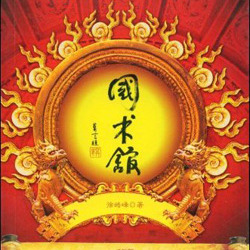
“The National Kung Fu School” ( 《国术馆》)
The main character is a young man who believes he was director of the school of the title in Nanking in the 1920s. He is described with great humor, continuing to apply rules from another age, like a a sort of Don Quixote embarked on an absurd and tragic journey. He preserves his values and his personal esteem, but is condemned to failure, symbol of a world itself condemned by modernity.
At the same time as his style asserts itself, his thinking becomes more complex. His short story “Survive” ( 《劫活》 ) takes place around a go board in the 1920s. The story is that of battles between Chinese and Japanese players, kung-fu masters, spies and Buddhist monks.
The complexity of the parallelism with the game of Go is illustrated by the title, which is a Go term, in fact. The whole game is based on a principle of life and death: circled pieces are 'dead', captured and eliminated from the game; one must capture (劫jié ) to survive (活huó ) , a vital principle of the Warring States period which saw the development of the game.
Xu Haofeng's latest novel returns to the theme of the game of go, but coupling it with a Buddhist theme. Published in November 2010 , it is titled “The Mandala of Enlightenment” ( 《大日坛城》 ) . The title refers to the s ū tra Maha Vairocana ( 《大日经》) , one of the two essential sutras of the Tibetan and Japanese tantric schools ; arriving in China at the very beginning of the 8th century , it was translated in 724-25, and the translation then reached Japan. The Sanskrit original having disappeared, it is this Chinese version which is the oldest.

“The mandala of enlightenment”
( 《大日坛城》)
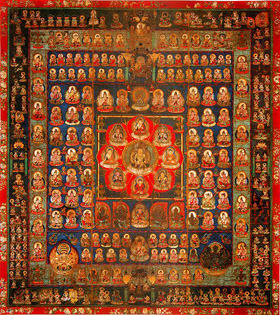
the mandala of the Maha Vairocana sutra
According to this tradition, when the Buddha had achieved enlightenment, he remained in the form of Vairocana for seven days during which he transmitted his teaching to Vajrapani and other bodhisattvas , an obviously symbolic transmission. However, it is the game of go that is at the center of the story, because the main character was a master in China in the 1940s, at the time of the Sino-Japanese War. Go competitions, likened to martial arts competitions, reflect the struggle between the two countries, but inverted: while the Japanese run from victory to victory, the go master remains invincible...
The three elements, esoteric Buddhism, martial arts and the game of go, are linked in the novel by
convergent symbols; Xu Haofeng seems to make them the three components of a “way” ( “道”) of salvation.
-https://www-chinese--shortstories-com.translate.goog/Auteurs_de_a_z_XuHaofeng.htm?_x_tr_sch=http&_x_tr_sl=fr&_x_tr_tl=en&_x_tr_hl=en&_x_tr_pto=sc
#xu haofeng#lost in translation#best overview of his writing i've come acorss so far#but still not what I was trying to find again
11 notes
·
View notes
Photo

桐生 一馬, Kiryū Kazuma
応龍 - Oryu, “Responsive Dragon” (Yinglong)
Type: Traditional
Artist: Utabori
Features: Ascending Black Oryu (Yellow/Yinglong "Responsive Dragon") holding a Pearl with Sanskrit for Dainichi Nyorai/ Vairocana (the Buddhist guardian of the year of the monkey- 1968. Kiryu’s birthday.)
Oryu - Depictions of dragons in Japan are greatly influenced by the Chinese dragon, though Japan does have its own native dragon myths. While in China dragons are primarily associated with the element of wood, in Japan dragons are also associated with water and rain. Japanese myth tells of a coral Dragon Palace in the ocean. Eastern dragons are powerful and fearsome, but mostly benevolent creatures known to protect temples and help and reward virtuous people. One of the 4 Guardians of Kyoto is the Azure Dragon, who protects the east. (The others are The White Tiger to the west, Black Turtle to the north, and Vermillion Bird to the south)
"Oryu" is the Japanese name for the Chinese "Responsive Dragon" or "Yinglong." It is a rain deity, and lends its power to The Emperor, in one case pointing out where channels should be dug to divert flood water.
Black - Black is associated with death in Japan, but is also used in formal settings like weddings and is considered a masculine color. Black dragons are associated with experience and wisdom.
Pearl - Eastern Dragons are often depicted carrying a pearl, sometimes clutched in its claws or beneath the neck. While the exact origin of the pearl is unknown, it has come to represent the dragon’s authority, the moon, the sun, and control of water.
In Buddhism the years are assigned guardian deities, with the year of the Sheep and the Monkey being overseen by Dainichi Buddha (known as Vairocana in India) Dainichi is called the “Cosmic Buddha” and represents the center, light and the sun.
(Being born in 1968, Kiryu is an Earth Monkey, who are characterized as being intelligent, frank, optimistic, fearless and lovers of practical jokes.)
Flames - Passion, Energy, desire, movement
#kiryu kazama#yakuza#yakuza games#ryu ga gotoku#yakuza kiwami#yakuza 1#yakuza 2#yakuza 3#yakuza 4#yakuza 5#yakuza 6#yakuza 7#dead souls#dragon#tattoo#year of the monkey#black dragon#irezumi#rgg#flames#like a dragon
199 notes
·
View notes
Text
NEW THEORY SHARED BY BAELI - ORIGINALLY CAME FROM JANE ✨

Funny cuz last night I was thinking about this color combinations too and how I was idiotically thought that these could be a deeper connection to what his Six Eyes contained lmao 💀
Interestingly however, since most of the things in JJK are influenced by Buddhism, I took my time searching for the symbolism of White color, and this is what showed up first: What caught my attention? A buddha named Vairocana.

Since it’s already pretty late here, I’m going to share some of the screenshots (you can read more from here) that I feel like it’s closely related to their theory and probably mine as well lol.
Please click on the pics for full view!



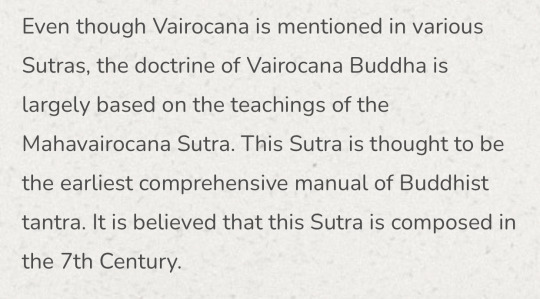

Let me add more cuz I just found another interesting information (here’s the link!)
It said, “THE FIVE DHYANI BUDDHAS are the representations of the five qualities of the buddhas. It is also called “Five Wisdom Tathagatas”.
Let’s make it short then:
The name of the Buddhas: — the colors of complexion — their representation — location :
1) Akshobya
— Blue-Black — Consciousness + East
2) Amitabha
— Red — Compassion + West.
3) Amoghasiddhi
— Green — Accomplishment + North.
4) Ratnasambhava
— Yellow — Richness + South.
5) Vairocana
— White — Wisdom — Center.
19 notes
·
View notes
Photo


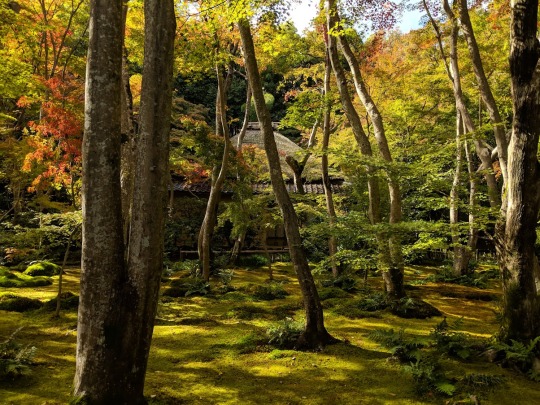
(I've mostly given up on the Chinese sections since it's not a language I'm studying, but if anyone can figure out the characters I'm missing, I'll happily amend the post. Also feel free to create a Chinese vocab list, if you'd like. :3)
祇王寺 (往生院)
往生院祇王寺と号する真言宗の寺である。寺伝によれば、この地は、平安時代に、法然上人の弟子、念仏房良鎮��往生院を開創し、後に祇王寺と呼ばれるようになったと伝えられている。
平家物語によれば、祇王は、平清盛に仕えた白拍子であったが、仏御前の出現により清盛の心が離れてしまったので、母刀自、妹祇女と共に出家し、当地に移り住んだ。後には、仏御前も加わり念仏三昧の余生を送ったと伝えられている。 現在の本堂は、明治二十八年 (一八九十)に再建されたもので、堂内には、本尊大日如来像をはじめ、平清盛と祇王ら四人の尼僧像を安置している。
境内には、祇王姉妹寺の墓と伝える宝筐印塔及び平清盛の供養塔などがある。
京都市
Gioji Temple (Ojoin Temple)
The Gioji Temple, of the Shingon Buddhist sect and formerly known as Ojoin, is said to have been founded by Nembutsubo Ryochin, a disciple of the priest Honen.
The main building, reconstructed in 1895, enshrines a statue of the Buddha Dainichi, who symbolizes oneness with the universe. There is also a statue of Taira no Kiyomori, the 12th century Taira clan chieftain, and fours statues of nuns, one of whom is Gio, a great beauty who had renounced the world while still young after she had lost favor with Kiyomori.
In the precincts stands a pagoda which is said to be the grave of Gio and her sister, and another pagoda dedicated to Kiyomori.
Kyoto City
祇王寺 (往生院)
祇王寺属真言宗派寺院、据寺传记載、在平安時代、法然上人的徒弟念佛房良镇开创了往生院、后来被称为祇王寺。于1895年得到重建的正殿内、除供*着本尊大日如来佛像外、还安置着平清盛以及祇王寺4位尼姑的*像。
寺内还保存着据说是王姐妹等人之墓的宝筐印塔以及平清盛的祭祀塔。
기오지 (오조인) 절
진언종 사찰로 절에 전해 오는 이야기에 의하면 헤이안시대에 호넨 큰스님의 제자 넨부쓰보 료친이 오조인 잘을 갸창해였으며, 후엘 기오지라 불리게 되었다고 한다.
본당은 1895년 재건된 것으로 그 내부에는 본존 다이니치여래상을 비롯해 다이라노 기요모리 상 및 기오 등 4명의 비구니 상이 안치되어 있다.
경내에는 기오 자매 등의 묘라고 전해지는 부협인탑과 다이라노 기요모리 공양덥 등이 있다.
쿄토시
Japanese
号する (ごうする) to name, take a second name
真言宗 (しんごんしゅう) Shingon sect
法然 (ほうねん) Honen
上人 (しょうにん) holy priest, saint
念仏房良鎮 (ねんぶつぼう・りょうちん) Nembutsubo Ryochin
開創 (かいそう) initial opening [esp. of a temple]
平清盛 (たいらのきよもり) Taira no Kiyomori
仕える (つかえる) to serve, attend
白拍子 (しらびょうし) dancing girl [end of Heian period]
仏御前 (ほとけごぜん) Hotoke-gozen, a dancing girl
母刀自 (おもとじ) mother [archaic]
祇女 ? Gio?
出家 (しゅっけ) entering the priesthood
念仏三昧 (ねんぶつざんまい) being deep in prayer; praying fervently to Amida Buddha
余生 (よせい) the rest of one's life
送る (おくる) to spend (time), to live one's life
本堂 (ほんどう) main temple building
再建 (さいこん) rebuilding (a temple or shrine)
本尊 (ほんぞん) principal object of worship at a temple (usu. a Buddha or bodhisattva)
大日如来 (だいにちにょらい) Daichi Nyorai/Vairocana/Mahavairocana
尼僧 (にそう) nun, priestess
安置 (あんち) enshrinement, installation (of an image)
境内 (けいだい) grounds (esp. of shrines and temples), precincts
宝筐印塔 (ほうきょういんとう) a type of pagoda that's a grave/memorial tower
供養塔 (くようとう) memorial tower
Korean
절 Buddhist temple
진언종 Shingon sect
사찰 Buddhist temple
큰스님 great Buddhist monk, monk of virtue
제자 student, disciple
본당 main temple, hall of a temple
재건 reconstruction, rebuild
내부 the inside, interior
본존 the object of worship, principal icon
다이니치여래 Mahavairocana
상 statue, figure
비롯하다 to begin, start
및 and, as well as
자매 sister
묘 grave, tomb
전해지다 to be told, conveyed; passed down
공양드리다 to make an offering to Buddha
#日本語#Japanese vocabulary#Japanese language#日本#嵐山#仏教#Arashiyama#Buddhism#한국어#Korean vocabulary#Japan#京都#Kyoto#Japanese langblr
23 notes
·
View notes
Text
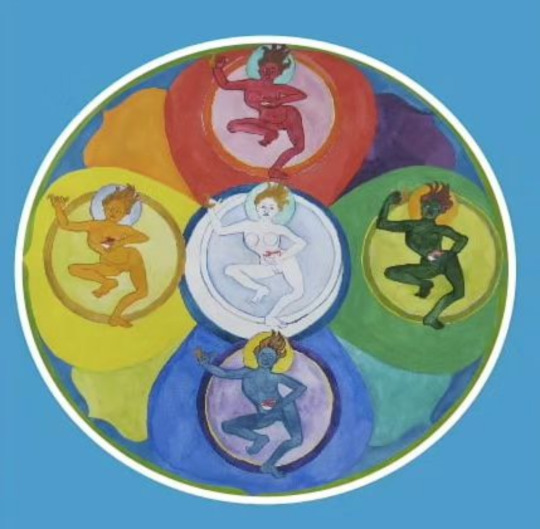
The Five Wisdom Dakinis
The designation "Wisdom Dakinis" or "Awareness Dakinis" refers to five significant deities in Tibetan Buddhism, appearing in the Bardo Thödol (Tibetan Book of the Dead) during the first five days of the bardo, each in inseparable union with one of the five Sambhogakaya Buddhas. These Dakinis are regarded as emanations of Vajravarahi, a key figure in Vajrayana Buddhism.
1. Akashadhatvishvari - Buddha-Dakini:
- Appears on the 1st day at the Center, in union with Vairocana (or with Ratnasambhava or Akshobhya).
- Color: White.
- Element: Ether.
- Represents the Wisdom of Universal Law.
2. Locana - Vajra-Dakini:
- Appears on the 2nd day in the East, in union with Aksobhya (or with Vairocana in the East).
- Color: Blue.
- Element: Water.
- Represents the Wisdom of the Mirror.
3. Mamaki - Ratna-Dakini:
- Appears on the 3rd day in the South, in union with Ratnasambhava (or with Akshobhya in the Center).
- Color: Yellow.
- Element: Earth.
- Represents the Wisdom of Equality.
4. Pandaravasini Pandara - Padma-Dakini:
- Appears on the 4th day in the West, in union with Amitabha.
- Color: Red.
- Element: Fire.
- Represents the Wisdom of Distinction & Discernment.
5. Samayatara Samaya Tara - Karma-Dakini:
- Appears on the 5th day in the North, in union with Amoghasiddhi.
- Color: Green.
- Element: Air.
- Represents the Wisdom of Action & Accomplishment.
These Dakinis are not only symbolic representations but are also revered as spiritual guides, embodiments of enlightened qualities, and sources of wisdom and empowerment. Their associations with specific Buddhas, elements, and colors signify various aspects of enlightenment and spiritual realization. Despite their profound significance, they are sometimes erroneously diminished by merely being referred to as the "Five Consorts," underscoring the need for a deeper understanding of their roles and symbolism within Tibetan Buddhism.
#Dakini#buddha#buddhist#buddhism#dharma#sangha#mahayana#zen#milarepa#tibetan buddhism#thich nhat hanh
3 notes
·
View notes
Photo

Tibetan Buddhist deity Sarvavid Vairocana, also referred to as the All-knowing Buddha, embodies a visualization practice that is said to lead meditators to enlightenment.
67 notes
·
View notes
Text


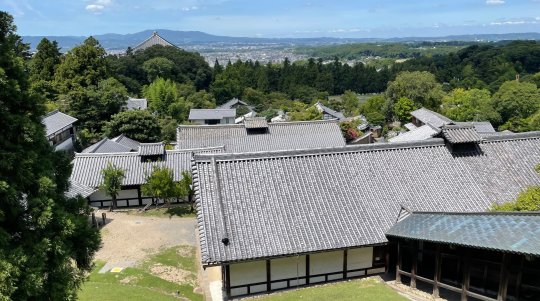
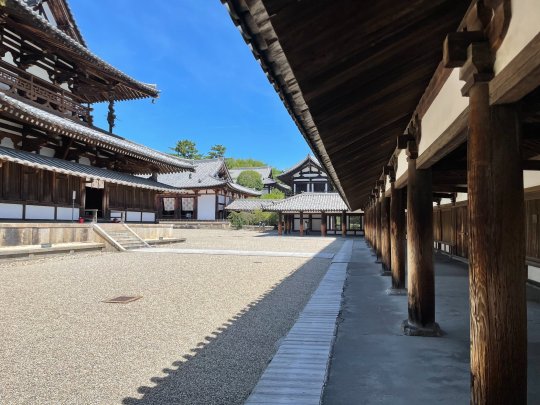
Some photos of Todaiji Temple (東大寺) taken by Izumi-san during a visit to Nara Park (奈良公園), located within Nara Prefecture in southern Kansai, Japan. The temple is primarily known for its Daibutsuden (大仏殿, "Great Buddha Hall") housing the world's largest bronze statue of the Vairocana, not present in these.
Being the obvious Japanese culture analog, aspects of the architecture here will be seen in the Kadoe lands, which made a very brief appearance in chapter 11:

The full extent of ancestral Japanese architecture's influence will likely appear in Tei's backstory much later on.

From Todaiji Temple's official website:
The origins of Tōdai-ji lie in a temple called Kinshō-ji which was founded in 728 for the repose of the spirit of Crown Prince Motoi, son of Emperor Shōmu (r. 724-749). In 741 when the Emperor issued his edict ordering the construction of a national system of monasteries (Kinkōmyō-ji) known as the Kokubun-ji, Kinshō-ji was elevated in status. In 743 Emperor Shōmu issued his proclamation for the erection of a Great Buddha Image and when the capital was returned to Heijō (Nara) construction of the colossal image of Vairocana was begun on the grounds of the Kinkōmyō-ji and was completed in 749. Construction of the Great Buddha Hall took place concurrently and the image was dedicated in 752 with a lavish consecration ceremony. Subsequently the Office for the Construction of Tōdai-ji supervised the building of the West and East Pagodas, the Lecture Hall and Monks’ Quarters to complete the temple complex.
Because Tōdai-ji was the chief temple in the Kokubun-ji system, it was a center for rituals for the peace of the nation and the prosperity of the people; it also functioned, however, as a center for the training of scholar monks who studied Buddhist doctrine.
After the start of the Meiji period in 1868 edicts legislating the separation of Shinto and Buddhist religious establishments and the confiscation of temple lands threatened the existence of Tōdai-ji. Nevertheless, the temple managed to carry out major repairs to the Great Buddha Hall at the start of this century and again in the 1970s and has striven to preserve the extensive compound with all its structures. Tōdai-ji today preserves many precious cultural treasures from the temple’s past, yet it also is a treasure house of traditional Buddhist rituals such as the Shuni-e held at the Nigatsu-dō. Many people from throughout Japan and the world visit the temple to worship and pay their respects every year.
3 notes
·
View notes